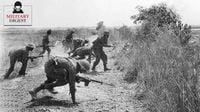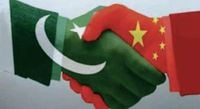The Central Intelligence Agency (CIA) has recently declassified a National Intelligence Estimate (NIE) prepared in 1993, evaluating the potential for war between India and Pakistan during the 1990s. Released in February 2025, this historical document sheds light on the enduring tensions between the two nuclear-armed neighbors, which have escalated in recent weeks following a brutal terrorist attack.
According to the NIE, the likelihood of a conventional war between India and Pakistan was assessed at about 1 in 5. However, the report emphasized that a war could still erupt due to various factors, including a "spectacular terror outrage that one side believed the other directed or abetted." As tensions rise, these warnings resonate with current events.
Recently, a terrorist attack in Pahalgam, Kashmir, left 26 civilians dead, most of whom were Hindu tourists. The attackers, armed with AK-47s and M4 carbines, were linked to the Pakistan-based group, Lashkar-e-Taiba, through its front organization, TRF. This incident has reignited fears of military confrontation between India and Pakistan, with both nations accusing each other of escalating hostilities.
In the wake of the attack, Indian Prime Minister Narendra Modi vowed "severe punishment" for those responsible, while Pakistani officials claimed they had "credible intelligence" of an imminent Indian military strike. This exchange of threats has left civilians on both sides of the Line of Control (LoC) bracing for potential conflict.
In Muzaffarabad, the capital of Pakistani-administered Kashmir, residents are reinforcing bunkers and preparing evacuation plans. Azeem Gilani, a local baker, expressed a common sentiment: "God willing, nothing will happen. We have seen this before. But if, God forbid, the situation worsens, Kashmiris on both sides will suffer." The fear of military escalation is palpable, with families stocking up on essential supplies and hospitals preparing for emergencies.
According to local shopkeeper Tanzeel Ahmed, many residents are unable to afford the necessary preparations for conflict. "Preparing for conflict is not just about fear; it is about whether you can afford to survive it," he said. With the tourism season typically beginning in early May, the region's economic backbone is under threat as cancellations pour in and access to sensitive areas is restricted.
Shahid Chaudhary, a guesthouse owner, lamented the impact of the current situation on his business, stating, "All 42 rooms are vacant, and we’ve had to let our staff go. The losses are devastating." The attack has not only claimed lives but has also cast a shadow over the region's economy, which relies heavily on tourism.
In response to the growing threat, Pakistani officials have instructed the food department to stockpile emergency supplies for two months, anticipating possible military action from India. Additionally, hundreds of madrassas, or religious seminaries, have been ordered to close temporarily amid fears they could be targeted in airstrikes.
The NIE from 1993 noted that both India and Pakistan would likely continue supporting militant activities in each other’s territories. While Pakistan has been more aggressive in its support for secessionists in Kashmir, India has also engaged in limited support for ethnic separatists in Pakistan. The report highlighted that both nations fear the implications of extremist attacks, which could prompt military retaliation or international sanctions.
Despite the potential for conflict, the NIE suggested that leaders on both sides are wary of the catastrophic consequences of nuclear escalation. The document outlined several reasons why war might not be imminent, including the understanding that neither military could achieve victory at an acceptable cost, especially given budget constraints and internal security duties.
However, the NIE also presented scenarios under which war could still break out, such as pre-emptive strikes by Pakistan if it believed an Indian attack was imminent or retaliatory actions following significant terrorist incidents. The report recalled past crises, including the 1987 and 1990 standoffs, which were marked by military brinkmanship and diplomatic interventions.
As the situation continues to evolve, analysts are examining the implications of China's role in supporting Pakistan's military posture. Recent reports indicate that the Pahalgam attack may have benefited from sophisticated technology supplied by Chinese firms, raising questions about Beijing's involvement in regional tensions. In a precarious balance, China seeks to challenge India's rising influence while simultaneously needing India as a partner in its broader geopolitical strategies.
The dynamics of the India-China relationship have shifted significantly in recent years, particularly after the onset of the U.S. trade war. As India emerges as a viable alternative in global supply chains, China finds itself grappling with the implications of a more assertive neighbor. This context adds layers of complexity to the already fraught India-Pakistan relationship.
Ultimately, the civilian population in Kashmir remains caught in the crossfire of these geopolitical tensions. As the threat of conflict looms, the people of Kashmir are left to navigate a landscape marked by fear and uncertainty. The historical context provided by the declassified NIE serves as a reminder that while the specter of war may fluctuate, the underlying issues driving the conflict persist.
As the world watches, the future of Kashmir hangs in the balance, with the potential for violence always lurking just beneath the surface. The stakes are high, and the consequences of miscalculation could be dire for all parties involved.





